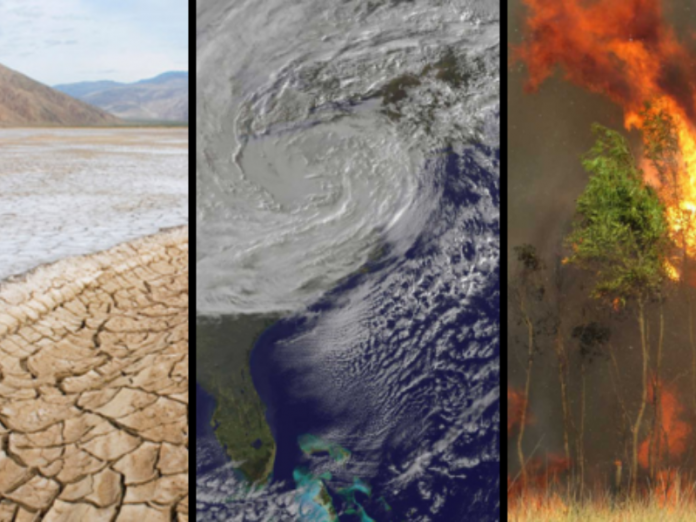YOU SHOULD SUBSCRIBE TO CLIMATE CHANGE WEEKLY.
IN THIS ISSUE:
- Droughts, Hurricanes, Wildfires Aren’t Living Up to Alarmists’ Expectations
- Podcast of the Week: Third Parties: The Silent Movers of American Politics (Guest: Dr. Merrill Mathews, Jr.)
- List of Notables Signing ‘No Climate Emergency’ Declaration Grows
- Alberta Suspends Wind and Solar Project Approval
- New York Authorities Warn of Growing EV Fires
- Video of the Week: Global Greening – The Good Kind of Green (featuring Dr. Will Happer)
- Climate Comedy
- Recommended Sites
Miss Anything at Heartland’s Climate Conference? No Problem.
Droughts, Hurricanes, Wildfires Aren’t Living Up to Alarmists’ Expectations
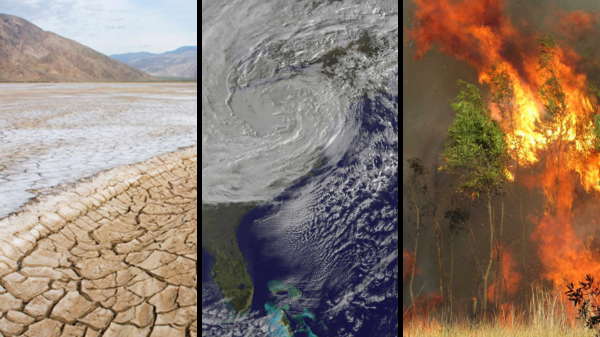
Just before the beginning of summer last year, I wrote a Climate Change Weekly article titled “It’s Climate Catastrophe Du Jour Season, Again!,” warning of what I predicted would be a coming tidal wave of stories claiming the then-extended drought and expected hurricanes and wildfires would be blamed on climate change. I was right. Hundreds if not thousands of stories were published by both the mainstream and progressive fringe media last year blaming the drought, every hurricane, and large wildfire season on climate change.
This despite there being no evidence that long-term trends in droughts, hurricanes, and wildfires showed any increase in number or severity. Absent such upward trends, it’s hard to honestly link one or a few years of extreme weather events to climate change, but then honesty has never been a strong point for climate alarmists or at the heart of the climate change debate.
With the current summer coming to an end, let’s revisit the dread three seasons—drought, hurricanes, and wildfires—and see how they went in 2023.
Headline stories on drought have been nearly nonexistent this year. That’s because, as I write on August 29, the U.S. Drought monitor reports nearly 57 percent of the United States is exhibiting no drought whatsoever despite a long, admittedly hot summer. Another 16 percent is recorded as “abnormally dry,” and only 27 percent of the country is listed as being in any category of drought, from moderate to extreme (5 percent) or exceptional (1 percent). Three months ago, at the beginning of summer, 66 percent of the nation was completely drought-free, with only 16 percent of the country listed as facing moderate, severe, extreme, or exceptional drought.
As El Niño left, it dumped huge amounts of precipitation across the country, and especially in the historically drought-prone western United States, much of it in the form of record-setting snow, resulting in a nearly record-low percentage of the country being considered very dry.
At the beginning of the “water year” in September 2022, the U.S. Drought Monitor recorded just 36 percent of the country was at any level of drought. As of September 27, 2022, more than 41 percent of the U.S. was experiencing some degree of drought—25 percent with severe, extreme, or exceptional drought—and 63 percent of America was listed as abnormally dry, at a minimum.
Oh, what a difference a year makes, not in climate but in weather—and in media coverage of claims of climate-induced drought!
With the Maui wildfire a recent memory and Hurricane Idalia hammering Florida’s Gulf Coast, it may seem an inopportune time to bring up wildfires and hurricanes, but that’s not so. As I’ve previously discussed, neither the wildfire in Maui, nor those in Canada, nor the ones that scorched Greece this summer, were caused by climate change: nature combined with human error, malfeasance, or evil was behind each of these devastating fires.
As of August 11, data showed wildfires in the United States in 2023 are the fourth-lowest in nearly 100 years of recordkeeping. Globally, over the past two decades of modest warming (but heightened fearmongering), satellite data from NASA show a 25 percent decrease in acreage lost to wildfires since 2003.
That leads us to the 2023 hurricane season and Hurricane Idalia. Although the global average temperature, a made-up metric if ever there was one, has increased modestly over the past 150 years, neither the U.N. Intergovernmental Panel on Climate Change nor hard data shows any increasing trend in the number or severity of tropical cyclones. Over the past 50 and 100 years, if anything, the data indicates there has been a modest decline in the yearly number of hurricanes and major hurricanes on average, according to multiple studies.
What’s true for the whole world is true also for the United States and Florida. From 2009 through 2017, America experienced the fewest hurricane strikes in any eight-year period in recorded history. And it was just in 2016 that Florida, America’s most vulnerable state for hurricanes, concluded an 11-year period without a landfalling hurricane, the longest such period in recorded history.
The “official” hurricane season runs from June 1 through the end of November. This year, until the past week, tropical storm numbers and accumulated energy or sustained wind speeds were below normal. The hurricane season typically peaks in late-August through mid-September, so there is absolutely nothing unusual about multiple storms forming during this short time span.
Idalia forming and strengthening now is not only not outside the norm, it fits the historic pattern perfectly.
This year’s climate disaster de jour season has been a bust so far. This is good for people but bad for those who hype the narrative that “climate change causes everything.” That is not true now, nor has it ever been.
Sources: Climate Change Weekly; U.S. Drought Monitor; Electroverse;
Get your Copy at Amazon TODAY!
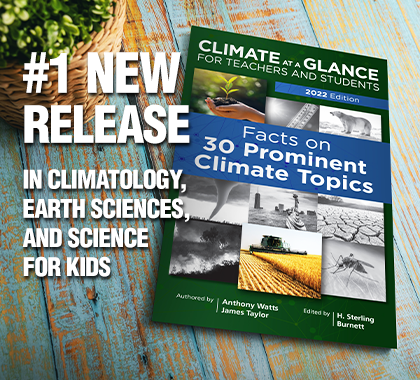
Podcast of the Week
In this special episode of The Heartland Daily Podcast, Sterling Burnett sits down with Dr. Merrill Mathews, Jr., a resident scholar at the Institute for Policy Innovation and a policy advisor to The Heartland Institute. They delve into the often-overlooked but crucial role that third-party candidates have played in shaping American elections. From historical impacts to the upcoming elections, this episode offers a comprehensive look at how third parties can be game-changers in the political landscape. Also, get insights into the Senate race involving Krystin Sinema and what’s at stake. Don’t miss this enlightening conversation that steps outside the usual climate and environmental topics to explore the intricacies of U.S. politics.
Subscribe to the Environment & Climate News podcast on Apple Podcasts, iHeart, Spotify or wherever you get your podcasts. And be sure to leave a positive review!
List of Notables Signing ‘No Climate Emergency’ Declaration Grows
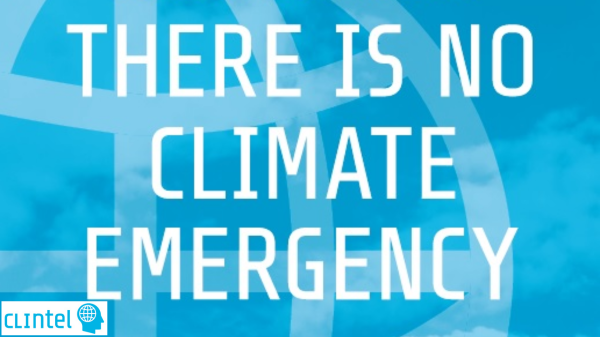
In 2019, the independent research institute Climate Intelligence, also known as CLINTEL, was founded.
Among its most prominent educational efforts to date was the development and issuance of a declaration in 2022 saying, among other things, climate change is not a crisis. CLINTEL called on scientists and scholars who’ve worked on the climate issue or in climate-related fields to sign the declaration. More than 1,100 did. Full disclosure: I signed the declaration. Since then, 500 more climate experts from all over the globe have signed the declaration, and the list now includes two Nobel Prize winners: Norwegian engineer and physicist Ivar Giaever, Ph.D. and, recently, John Clauser, recipient of the 2022 Nobel Prize for Physics.
CLINTEL’s declaration says the data shows there is no “crisis” being driven by climate change and requiring a big government response to limit fossil fuel use. The letter states a variety of natural factors have influenced and driven climate change throughout history and that climate models blaming the recent shift on human greenhouse gas emissions have repeatedly failed to accurately reflect data on items such as temperatures and extreme weather.
Among the fact-checkable, confirmable statements made in CLINTEL’s increasingly popular declaration are these:
The geological archive reveals that Earth’s climate has varied as long as the planet has existed, with natural cold and warm phases. The Little Ice Age ended as recently as 1850. Therefore, it is no surprise that we now are experiencing a period of warming.
CO2 is not a pollutant. It is essential to all life on Earth. More CO2 is favorable for nature, greening our planet. Additional CO2 in the air has promoted growth in global plant biomass. It is also profitable for agriculture, increasing the yields of crops worldwide.
Because data shows extreme weather events are not increasing, temperatures are within their historical normal range, and CO2, rather than being a pollutant, is critical for life on Earth, CLINTEL’s declaration, as summed up by Cowboy State Daily, is,
there is no climate emergency [to justify] eliminating fossil fuel usage by 2050. Instead of policies that mitigate emissions, whatever the causes of the warming trend, the declaration calls for adaptation.
This would mean, for example, it’s better to ensure people have affordable, reliable energy to run their air conditioners when temperatures are high.
In an interview with Cowboy State Daily, Clauser explained his decision to sign CLINTEL’s declaration. Clauser says the recent warming trend is strongly influenced by natural factors and patterns which aren’t being adequately accounted for.
Concerning the idea there is a scientific consensus that humans are causing catastrophic climate change, Clauser said, “There’s a growing group of scientists who are in strong disagreement. No, it’s certainly not as unanimous as Al Gore thinks.”
Sources: Cowboy State Daily; The New American
Heartland’s Must-read Climate Sites
Alberta Suspends Wind and Solar Project Approvals

At the direction of the Alberta’s provincial government, the Alberta Utilities Commission (AUC) is imposing a six-month moratorium on approvals of wind and solar power projects greater than one megawatt. The action comes amid growing concerns about the impact of fast-expanding wind and solar development on rural, especially agricultural, lands, recreation and scenery, waste disposal, and the reliability of the electric power system.
“With few regulatory barriers to entry and abundant wind and sunshine, Alberta has been a leader in renewable energy development in Canada,” reported Global News in a story on the policy shift. “In 2022, 17 per cent of the province’s power came from wind and solar—exceeding the province’s 15 per cent goal.”
Nathan Neudorf, minister of affordability and utilities, said increasing numbers of people were expressing concerns during the AUC’s public hearings about the impact of the rapid expansion of wind and solar industrial facilities on grid reliability and the environment. The moratorium was adopted while 15 renewable energy projects were under consideration by the AUC.
Representatives of rural municipalities had been pushing for more detailed examination of wind and solar development, with Paul McLaughlin, president of Rural Municipalities Alberta, saying the concerns of rural residents and governments, where the renewable industrial facilities are overwhelmingly cited, should be given additional weight.
“Rural municipalities cover roughly 85 per cent of Alberta’s land and their voices must be included in the approval process for all renewable energy projects,” McLaughlin said in a press statement when the moratorium was announced. “We look forward to working with the Government of Alberta to create an approval process that balances provincial and local perspectives.”
During the moratorium, the AUC is undertaking an official inquiry into the impact of the use of “agricultural and public land for wind and solar projects, land reclamation, and the role of municipal governments in land selection for project development and review.”
Andrew Leach, an economist with the University of Alberta, told Global News part of the reason for the moratorium is the government not having considered how such sites can be cleaned up, when it currently faces billions of dollars in clean-up costs for the oil and gas industry. Alberta’s government wants to avoid a similar problem with wind and solar.
Source: Global News
New York Authorities Warn of Growing EV Fires
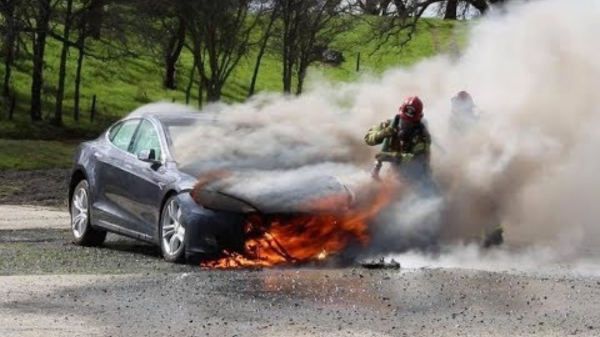
New York City public officials are blowing the whistle on electric vehicles for their tendency to catch fire spontaneously, which has led to millions of dollars in property damage and dozens of lives lost.
“The New York Fire Department [FDNY] recently reported that so far this year there have been 108 lithium-ion battery fires in New York City, which have injured 66 people and killed 13,” writes The Epoch Times. The paper quotes FDNY Commissioner Laura Kavanagh as saying, “There is not a small amount of fire, it (the vehicle) literally explodes . . . [with the resulting fire being] very difficult to extinguish and so it is particularly dangerous.”
In New York City in 2022, more than 200 fires from batteries of e-bikes, EVs, and other devices were reported by the FDNY. Since 2020, the FDNY reports, “lithium-ion battery fires have surpassed those started by cooking and smoking as the most common causes of fatal fires in New York City,” writes The Epoch Times.
In a case recounted by the paper, “a fire ignited at an e-bike shop and killed four people near midnight on the morning of June 20. Two individuals were left in critical condition.”
A second case, from April, was reported by CBS News New York:
Two siblings were killed … after their home in Queens burst into flames. The FDNY said the fire was started by a lithium-ion battery that belonged to an e-bike.
The flames went up so quickly, neighbors had to rescue people who jumped out of windows.
Kavanagh warned the public that when devices powered by lithium ion batteries catch fire, they “typically explode in such a way that renders escape impossible,” The Epoch Times article reported.
The story notes fires sparked by devices with lithium-ion batteries, such as cars, scooters, and bikes, are “happening all over the country,” and “Cars and e-bikes are randomly blowing up in driveways and garages.”
The truth is e-battery fires are happening all over the world, as detailed at Heartland Daily News and Climate Change Weekly. In the past year, two cargo ships carrying electric vehicles have experienced uncontrollable fires caused by electric vehicles spontaneously exploding. The ship fires claimed lives, and emergency crews were unable to put the fires out. One of the ships sank as a result.
Spontaneous combustion is not normal—except it is with EVs, and the fires they cause when they burst into flames are not normal fires. Insurers in Australia and elsewhere are starting to take note. That, more than anything else, may slow the pace of EV adoption. If insurers won’t insure EVs or they jack up rates considerably to offset the additional risk and to cover higher repair and replacement costs, will people still purchase them? If not, will governments force taxpayers to become the insurers of last resort?
Sources: The Epoch Times; Climate Change Weekly
Video of the Week
This week on Climate Change Roundtable, we dive deep into the benefits of global greening and discover how increasing atmospheric CO2 is leading to enhanced plant growth globally.
Our guest is William Happer. a distinguished physicist from Princeton recognized for his groundbreaking research in atomic physics, optics, and atmospheric science. He served as the Cyrus Fogg Brackett Professor of Physics at Princeton University and has been a prominent figure in the U.S. Department of Energy. Happer’s extensive research on the interactions between light and matter has paved the way for numerous technological advancements, and his insights into atmospheric phenomena have been pivotal in shaping our understanding of the environment.
In this episode, our host, Anthony Watts, and weekly panelist, Linnea Lueken, will delve into the science behind global greening. William Happer also reveals details and insights you haven’t heard before, shedding light on the lesser-known aspects of this phenomenon.
Watch every episode of The Heartland Institute’s Climate Change Roundtable show LIVE every Friday at 1 p.m. ET.


